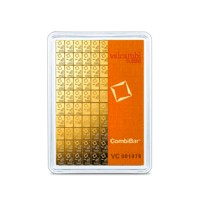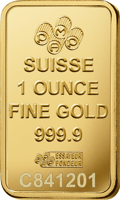Editor's Note: This was originally published in 2010.
What is Dollar Cost Averaging?
When it comes to buying precious metals, a solid strategy is essential.
Volatility is a natural part of investing in any asset, and every investor must contend with inevitable price fluctuations. However, investors may struggle to invest in bear markets and market downturns due to risk aversion. So how do you buy precious metals with this in mind?
There are many different ways to make decisions about how and when to buy gold and other precious metals. In order to diversify your portfolio and act as wealth insurance, any strategy for purchasing precious metals needs to focus on long term growth. One such method is Dollar Cost Averaging. Dollar cost averaging is a great tool for eliminating the temptation to give into fear and greed…

What is Dollar Cost Averaging?
Dollar-cost averaging is a strategy in which investors purchase or sell assets on a regular schedule, regardless of the price. The concept of dollar cost averaging was coined by economist Benjamin Graham in his 1949 book, The Intelligent Investor.
Dollar-cost averaging involves spreading your investment over time and at regular intervals, regardless of which direction the market or a particular investment is going. In theory, this investment strategy will spread out your investment entry points and result in lower average cost base over time, and therefore more potential growth.
Why is DCA Beneficial for Precious Metals Investors?
Dollar-cost averaging is a great way to scale your way into an investment without taking the amount of risk of timing a large purchase incorrectly. It’s much easier to stomach one poorly timed purchase if you're investing multiple smaller sums of money as the average should end up in your favor.
You won’t miss the bottom or the top of the market. Over time, dollar cost averaging lowers your overall cost of acquisition of the metals. It is nearly impossible to time market dips and buy at the lowest possible price every time, but purchasing at regular intervals makes it easier to invest consistently, with discipline and a long-term mindset.
It takes the emotion out of your investing habits. Two of the primary emotions that influence investors are fear and greed. Excessive fear can result in assets trading well below their intrinsic values and excessive greed can overinflate the values of assets beyond what they should be worth.
The best way to overcome fear and greed in trading is to develop a trading plan and then stick with it. Buying regular amounts of precious metals at regular intervals over the years and planning to hold them in the long-term will make it easier to ignore impulse selling and buying. Investors might otherwise give into the impulse to sell during times of negative sentiment caused by short-term fluctuations and even the longer downtrends in normal market cycles, or the impulse to buy only when markets are moving higher because sentiment has turned positive towards safe haven assets. This makes especially powerful dollar-cost averaging in recessions and bear markets.
Committing to this strategy means that you will be investing even when the market is down, and that's when investors can potentially score the best deals. It allows you to buy more precious metals at a lower spot price when the market is down and fewer ounces when it is up.
What are the Drawbacks to DCA?
Being over-committed to this strategy can lead to an unbalanced portfolio if you are not careful. If you are regularly buying precious metals, but you are not as committed to the adding other assets to your portfolio, then your portfolio may end up somewhat unbalanced in favor of gold. The World Gold Council, among others, conducted a number of surveys where they found that having roughly 8% to 12% allocation to gold tends to increase overall portfolio performance while decreasing overall portfolio risk.
If your allocation to gold shifts past this allocation, you might miss out on the potential benefits of other higher-growth assets. In this situation you may need to take a pause in your buying schedule, lower your buying amounts, or wait for a good opportunity to liquidate some precious metals holdings and rebalance.
Another drawback is potentially higher fees. If buying once a month means you can only afford fractional gold coins, then because of higher fabrication costs and premiums, you are going to end up paying more for the same amount of metals than if your buying interval is less frequent and in larger amounts like 1 oz. coins or even larger bars. This is important to keep in mind as you decide when and how much to purchase.
With dollar cost averaging, you might also miss out on potentially higher returns by adopting a passive approach to investing. If your decisions are unresponsive to the changing environment, you can miss out on timing specific market opportunities.
If the metals prices dip below your average cost of acquisition, and you have to liquidate your holdings for some reason (meeting margin calls or in a crisis/personal emergency), then this would be a loss. However, gold does its job in a portfolio only when you hold onto it in the long term. It’s only a loss if you get out of your position. With patience and the understanding that all markets move in cycles, if you continue to add and hold onto your metal while gold prices are low, the market will eventually turn in your favor.
What are Different Methods of Dollar Cost Averaging?
With dollar cost averaging, investors set a schedule once a pay period, weekly, biweekly, monthly, quarterly, etc. and make a contribution at this interval regardless of market conditions. The timing and the amount will depend on your budget and goals, and as your wealth grows, you may need to adjust this over the years. For an investor who wants a hands-off, healthy approach to investment management, this is a valid method of investing in precious metal that completely eliminates the need to pay attention to the markets.
Dollar cost averaging doesn’t necessarily mean buying your set amount on exactly the first of every month or quarter. Dollar cost averaging could also mean planning to buy once a month (or whatever your chosen interval is) and keeping an eye on the markets to take advantage of short-term dips around the timing of your interval. This more flexible method could work to capture higher returns, but it also runs more risk since no one can time the markets perfectly every time.
This could also add the risk of getting emotionally involved and you should not view the gold spot price going down the day after you buy as a loss or a mistake. It is crucial to keep a long-term view of the market with a focus on incremental growth over time. It is great if you can save a few dollars on your acquisition cost, but dips and rallies should not deter you from making the same regular contributions to your position. Remember that you committed to purchasing regularly with this strategy, no matter how bad or good gold or silver's performance is on a given day or week.
You Cannot Time the Markets
You can’t time the markets, and this strategy eliminates the need to. This way, you can focus on other aspects of your life and growing your wealth.
Dollar cost averaging is ideal for investors who don't have tons of cash to invest right away, have a low-risk tolerance, and don't want to concern themselves with the ups and downs of the market.
Asset Strategies International is not a financial advisory service, and we recommend that you reach out to a registered financial advisor for advice concerning your portfolio and specific financial situation. However, if the strategy of dollar cost averaging appeals to you, our preferred client representatives would be happy to help you find the bullion bars and coins that best fit your budget and goals… today!
Give us a call at 1-800-831-0007 or email us to add to your position.




